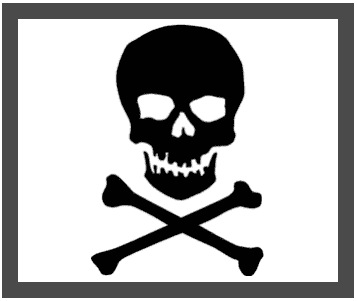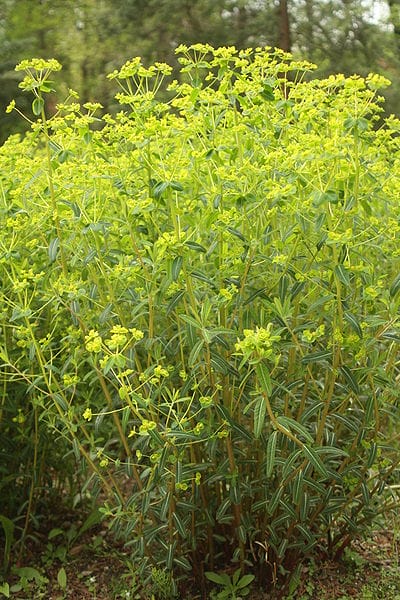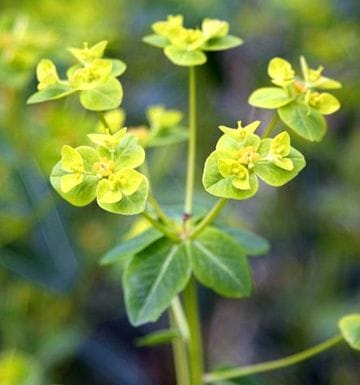Euphorbia pekinensis, Jing Da Ji 京大戟Jing Da Ji (TCM)Dur byid དུར་བྱིད། (Tibet) |

|

|

|
 Left & Above: Euphorbia pekinensis
Left & Above: Euphorbia pekinensisPhotos by Dalgial |
Botanical name:
Euphorbia pekinensis
E. fischeriana is also used in Tibet.
There are two types of Da Ji used in TCM:
- Euphorbia pekinensis (Jing Da Ji–the original source)
- Knoxia valerianoides (Hong Da Ji–more commonly used today)
Parts used:
Prepared Root
Temperature & Taste:
Cold, dry. Pungent, Bitter. Toxic
Note the Euphorbias are considered very hot in the western tradition.
Uses:
1. Purges Phlegm and Water:
-Fluid collection in the Chest or abdomen; Edema, Ascites (only in strong bodies)
-expectoration of thick sputum
-Cough with copious Phlegm
-good for “12 kinds of fluid-retention”. (Shen Nong Ben Cao)
2. Clears Phlegm, Resolves Masses:
-Scrofula, Lymphatic swellings from Phlegm
-used for “accumulation and assemblage”. (Shen Nong Ben Cao)
-“It dissolves abdominal mass”. (Da Ming)
-“purges hard mass and malignant blood”. (Zhen Quan)
-for “swellings in the neck and in the armpit”. (Ming Yi Bie Lu)
3. Clears Phlegm, Settles Wind:
-Apoplexy (Shen Nong Ben Cao)
–Headache
-“facilitates menstruation and purges a fetus” (Zhen Quan)
4. Treats Malaria
-traditionally used to treat Malaria
5. Externally:
-applied to red, swollen and toxic sores
-applied to Scrofula and Lymphatic swellings
-Toothache, chew a little of the root
-swelling of the feet, wash the feet in the decoction (Su Song)
Dose:
Prepared root: 1–3 grams
Substitute:
1. Euphorbia helioscopia Ze Qi “has similar functions to Euphorbia Da Ji“
2. Knoxia valerianoides Hong Da Ji is similar is function and use. It is considered milder in effect and is preferred unless the condition is severe or urgent. Knoxia Hong Da Ji is now used more commonly in China. Dose is the same.
3. Tibetan sources often list Castor plant (Ricinus) or Turpeth (as an accepted substitute) for Dur byid.
Corrective:
When taken with Jujube (Da Zao) it will not damage the Stomach and Spleen. (Li Shi Zhen)
Comment:
1. In some parts of China the unprocessed root is used. However, due to the fact that Vinegar preparation both corrects its toxic quality while enhancing its effectiveness, it should only be used internally in its prepared form.
2. This is prepared and used very similarly to Esula and Tithymalus (Euphorbia spp.) of the West, the use of which go back to antiquity. It is probable that their use was introduced to China.
3. Traditionally considered incompatible with Licorice (Euphorbia).
Preparation:
1. Vinegar-Prepared Root:
i. The root is soaked in enough vinegar to cover it, and boiled a little to allow most of the vinegar to absorb. Then it is gently stir-fried until almost dry, then left in the sun or a low over to dry thoroughly.
ii. it can also be prepared as per the western tradition for preparation of related Euphorbia species by soaking for 3 days in vinegar, then drying.
2. Ginger-prepared Root:
Decoct the root with Ginger until soft then dry in the sun. (Li Shi Zhen)
Main Combinations:
1. Serious Edema, Ascites:
i. decoct Euphorbia Jing Da Ji with Chinese Dates (Da Zao), then eat the Dates.
ii. in XinJiang (Uyghur region of Western China), Euphorbia Jing Da Ji and Jujubes (Chinese Dates, Da Zao) are decocted in Cows Milk
2. Water accumulation in the Chest or Abdomen, Euphorbia Jing Da Ji with Costus Mu Xiang
3. Ascites, Euphorbia Jing Da Ji with roasted Ginger
4. Cough, Pills were made of the dried herb cooked in starch water, then formed into pills the size of millet.
5. Wheezing, Emphysema, Euphorbia Jing Da Ji with Euphorbia Gan Sui, White Mustard seed (equal parts); powder, add excipient, and form pills. Dose: 1 gram.
6. Jaundice, Euphorbia Jing Da Ji with Artemisia Yin Chen Hao
7. Malaria, Euphorbia Jing Da Ji with Bupleurum Chai Hu, Ginger, Pinellia Ban Xia
Major Formulas:
Shi Zao Tang
Bright Red Decoction (Dmar chen thang) (Tibetan)
Pomegranate All Inclusive Pill (Se ‘bru kun ‘dus) (Tibetan)
Cautions:
1. Very irritant. Avoid overdose, only use full doses once lesser doses have not worked. Usually used for a short time only. It damages the Qi of the body and the Stomach and Spleen.
2. Not used during Pregnancy
3. Not used in the weak or frail. It is only for conditions of excess manifested with a strong or full pulse.
Antidote:
1. Calamus juice counters the poison (Li Shi Zhen)
Main Preparations used:
Li Shi Zhen:
“Phlegm and Damp accumulation will ascend and descend together with the movement of qi. It travels to all body positions. When such a lesion enters the Heart, it will stuff the orifice and cause epilepsy, illusion and delirium. When the lesion invades the Lung, it will cause coughing with the spitting of mucous phlegm, asthma with dyspnoea and cold feeling in the back. When it invades the Liver, it will hide and stay there, causing costal pain and dry nausea with intermittent chills and fevers. When the Channels and Collaterals are invaded, numbness, arthralgia and pain will ensue. When the lesion intrudes into the tendon and bone, it will cause referred pain in the neck, chest, back, waist, costal regions and hands and feet. Chen Wuze, in his book Sanyin Fang advocated that the above diseases could be treated with Kongxian Dan. It is a prescription that works wonders, designed to treat the root cause of phlegm accumulation, which is the accumulation of Water, or Humidity. When such pathogenic factor is intermingled with qi or Fire, it congeals into phlegm, or fluid-retention, or saliva, or phlegm, or watery stool. Euphorbia Da Ji is a drug that can purge the invading pathogenic Humidity resting with the Five Viscera and six Bowels. Euphorbia Gan Sui is a drug that can disperse the invading pathogenic Humidity resting with the Channels and Collaterals”.
Nothing at the moment.
